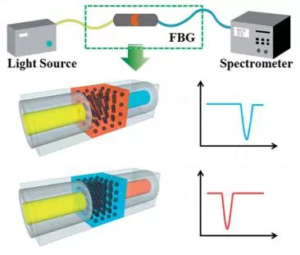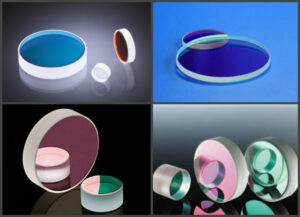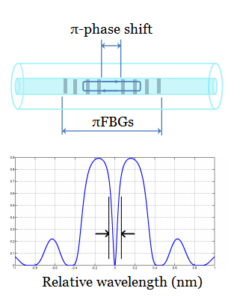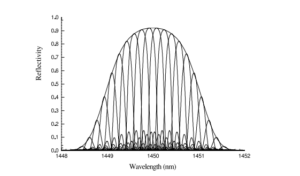 The FBG structure can change with the use of the refractive index, or the grating period. The grating period can be uniform or graded, and either localized or distributed in a superstructure. The refractive index has two main features, the refractive index profile, and the decline. The refractive index can be uniform or apodized, and the refractive index decline is positive or zero.
The FBG structure can change with the use of the refractive index, or the grating period. The grating period can be uniform or graded, and either localized or distributed in a superstructure. The refractive index has two main features, the refractive index profile, and the decline. The refractive index can be uniform or apodized, and the refractive index decline is positive or zero.
A superstructure fiber Bragg grating (SFBG), also called a sampled fiber Bragg grating, is a special FBG that consists of several small FBGs placed in close proximity to one another. SFBGs have attracted attention in recent years with the discovery of techniques allowing the creation of equivalent chirp or equivalent phase shifts. The biggest advantage of an SFBG with the equivalent chirp or equivalent phase shifts is the possibility to generate gratings with a greatly fluctuating phase and amplitude by adjusting the spatial profile of the superstructure. The realization of SFBGs with the equivalent chirp or equivalent phase shifts requires only sub-millimeter precision.
Superstructure (sampled) fiber Bragg gratings (SFBGs) are good optical filters for optical communication and optical sensor systems, because of their comb-like filter response. The length of SFBG is conventionally limited by that of the phase mask. However, the length of the high-quality phase mask fabricated by an interferometric technique is limited to ~ 5 cm. The main fabrication technique for long SFBGs based on scanning phase masks and trimming relative phases between FBGs. This technique permits to fabricate of long SFBGs with short phase masks. Superstructure fiber Bragg grating is a novel fiber Bragg grating. Because it is flexible, passive, low insertion loss, and small polarization dependent. It causes great interest and enthusiasm for the people in many areas. Ambient temperature and strain can both affect the sampled grating reflection spectrum.


 In order to make the fiber
In order to make the fiber  A
A  Nowadays, the special type of FBGs whose reflection spectrum has a notch arise from a π-phase discontinuity in the center of the grating (called
Nowadays, the special type of FBGs whose reflection spectrum has a notch arise from a π-phase discontinuity in the center of the grating (called  Fiber Bragg Gratings is one of the most meaningful developments in the areas of optical fiber technology, due to their flexibility and unique filtering performance. FBG is defined as the key component in dense wavelength division multiplexing on the basis of their low insertion loss, high wavelength selectivity, low polarization dependent loss, and low polarization modal dispersion.
Fiber Bragg Gratings is one of the most meaningful developments in the areas of optical fiber technology, due to their flexibility and unique filtering performance. FBG is defined as the key component in dense wavelength division multiplexing on the basis of their low insertion loss, high wavelength selectivity, low polarization dependent loss, and low polarization modal dispersion.